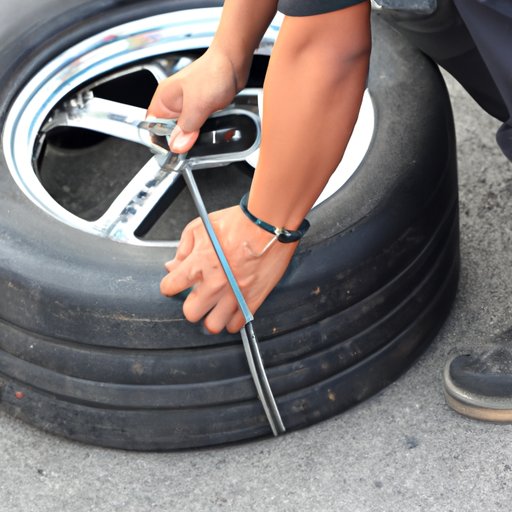
Introduction
As a driver, it’s crucial to know how to read a tire. Proper tire maintenance can help improve handling, extend the lifespan of your tires, and keep you safe on the road. In this article, we’ll go over everything you need to know about tire reading – from decoding tire size and ratings to identifying worn-out tread and ensuring proper tire pressure.
Beginner’s Guide to Tire Reading: Everything You Need to Know
Before diving into the specifics of tire size and ratings, it’s important to understand the key components of a tire. The tread refers to the grooved surface that comes into contact with the road. The sidewall is the side of the tire that faces outwards and often contains important information such as the tire brand, model, and size.
Basic tire information can often be found on the sidewall as well. This includes the brand name, the model of the tire, and the size. Knowing this information can help you determine whether a tire is compatible with your vehicle and what kind of performance you can expect.
Decoding Tire Size and Ratings: A Step-by-Step Guide
The numbers and letters on a tire’s sidewall might seem like a jumbled mess, but understanding them is crucial for proper tire maintenance. The size of a tire is typically indicated by a series of numbers and letters. For example, a common tire size is P215/65R15. The “P” indicates the tire is designed for passenger use, while the “215” represents the tire’s width in millimeters. The “65” indicates the tire’s aspect ratio (height to width ratio) and the “R” stands for radial construction. The “15” denotes the size of the wheel the tire is designed for in inches.
Tire ratings, such as speed rating and load index, are also important to understand. The speed rating indicates the maximum speed the tire can handle safely, while the load index indicates the maximum weight the tire can support.
How to Tell If Your Tire Tread Is Worn Out
Tire tread is crucial for maintaining traction on the road, especially in wet or slippery conditions. To check if your tire tread is still in good condition, you can use the penny test. Simply insert a penny into the grooves of your tire with Lincoln’s head facing down. If you can see the top of Lincoln’s head, your tread is worn down and it’s time to replace your tires.
Top 5 Things to Check on Your Tires Before Hitting the Road
Before driving, it’s important to inspect your tires for any potential issues. Here are five important things to check:
– Tire pressure: Proper tire pressure is essential for fuel efficiency, handling, and safety.
– Bulges or cracks in the sidewall: These can indicate a weakened tire that needs to be replaced.
– Uneven wear: This can indicate alignment or suspension problems.
– Tread depth: As mentioned earlier, insufficient tread depth can be dangerous.
– Objects stuck in the tire: Sharp objects such as nails or screws can puncture the tire and cause a flat.
Understanding Tire Pressure and How to Maintain It
Maintaining proper tire pressure is key for optimal performance and safety. To find the correct tire pressure for your vehicle, check the owner’s manual or the tire information sticker typically found on the driver’s side door jamb. To check your tire pressure, use a tire pressure gauge and make sure all tires are inflated to the recommended level. It’s important to check tire pressure regularly and especially before long trips.
Why Tire Rotation Is Important and How to Do It
Tire rotation involves moving the tires from one position on the vehicle to another. This can help extend the life of your tires and improve overall performance. The recommended tire rotation pattern varies depending on the type of vehicle and tire, but a common method is to move the front tires to the back and the back tires to the front. It’s important to rotate your tires regularly and follow the manufacturer’s recommended schedule.
Misconceptions About Tire Wear: Separating Fact from Fiction
There are many myths and misunderstandings when it comes to tire wear. One common misconception is that “all-season” tires are suitable for all seasons – in reality, they are only ideal for mild weather conditions. Another dangerous myth is that it’s safe to drive on bald tires in dry weather. In reality, insufficient tread depth can be dangerous in any weather condition.
Conclusion
Now that you have a better understanding of how to read a tire, you can start inspecting and maintaining your own tires with confidence. Remember to regularly check your tire pressure, inspect for potential issues, and rotate your tires as recommended. By taking good care of your tires, you can ensure safe and smooth driving for years to come.




